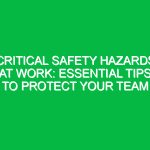Introduction
Good morning, team! Today, we’re going to dive into a critical topic that affects each and every one of us: Why We All Should Care about Toolbox Talks in the Health, Safety, and Environment (HSE) domain. Toolbox talks are not just another routine meeting; they are an essential part of our daily operations that can significantly enhance our Workplace Safety culture.
Understanding Toolbox Talks
Toolbox talks are short Safety meetings that focus on specific Safety issues related to our job tasks. Conducted before work begins or during breaks, these discussions are designed to raise awareness of potential Hazards, reinforce Safe Practices, and encourage open communication among employees. So, why is it vital to care about these talks? Let’s explore.
The Importance of Safety Culture
The first reason we should care about toolbox talks is their role in fostering a strong safety culture. A positive safety culture promotes an environment where employees feel responsible for their own safety and that of their coworkers. When we engage in toolbox talks, we cultivate a sense of community and shared responsibility, which is crucial in preventing workplace injuries and accidents.
Real-Life Example
Consider a scenario where a team is working at a construction site. Before starting their tasks, they hold a Toolbox Talk to discuss the potential Hazards of using heavy machinery. During this talk, they share experiences, discuss safe operating Procedures, and highlight the importance of wearing Personal Protective Equipment (PPE). As a result, team members become more vigilant and aware of their surroundings, reducing the risk of accidents.
Promoting Awareness of Hazards
Another critical aspect of toolbox talks is Hazard Awareness. Many workplace accidents stem from a lack of awareness regarding potential risks. By discussing specific hazards related to our tasks, we can equip ourselves with the knowledge needed to avoid them.
Common Hazards
Some common hazards that might be discussed in toolbox talks include:
- Slips, Trips, and Falls: These are among the most frequent workplace injuries. Regularly discussing the importance of maintaining clean work areas can significantly reduce these risks.
- Chemical Exposure: If your job involves handling hazardous substances, toolbox talks can help ensure that everyone knows the proper handling and emergency procedures.
- Machine Safety: Discussing safe machine Operation practices can prevent serious injuries and equipment damage.
Legal and Compliance Considerations
In addition to promoting safety, toolbox talks also help us comply with various Regulations and Standards. Many health and safety regulations require employers to provide Training and information on workplace hazards. By participating in toolbox talks, we ensure that we are meeting these legal obligations.
Compliance Benefits
Compliance with safety regulations not only protects employees but also shields the company from legal repercussions. Failure to adhere to safety standards can result in fines, legal actions, and increased insurance premiums, which can have long-term financial impacts on our organization.
Best Practices for Effective Toolbox Talks
To make our toolbox talks effective, we should follow some Best Practices:
- Be Relevant: Choose topics that are pertinent to the specific tasks and environment we are working in.
- Encourage Participation: Engage employees by asking open-ended questions and encouraging them to share their experiences and suggestions.
- Keep it Brief: Limit talks to 15-20 minutes to maintain attention and focus.
- Document Discussions: Keep a record of topics discussed and any action items that arise to ensure accountability.
Actionable Insights
Now that we understand the significance of toolbox talks, let’s discuss some actionable insights:
- Prepare Ahead: Before leading a Toolbox Talk, prepare your materials and consider potential questions that might arise.
- Set a Positive Tone: Start discussions with a positive note, perhaps sharing success stories related to safety improvements.
- Follow Up: After the talk, follow up on any action items or suggestions made during the discussion to show that employee input is valued.
Open Discussion
Now, I’d like to open the floor for any questions or comments. What are some safety concerns you feel are important to address in our future toolbox talks? Are there any experiences you would like to share that could help us improve our safety practices?
Reinforcing Our Commitment to Safety
As we wrap up today’s Toolbox Talk, it’s essential to remember that safety is everyone’s responsibility. By actively participating in toolbox talks and taking the information we discuss to heart, we can enhance our Workplace Safety culture and reduce the risks associated with our jobs.
Conclusion
In conclusion, Why We All Should Care about toolbox talks in the HSE context cannot be overstated. These discussions are vital for promoting safety awareness, ensuring compliance with regulations, and fostering a culture of accountability and care for one another. Thank you for your attention and your commitment to making our workplace a safer environment. Let’s continue to support each other and strive for excellence in safety every day!


